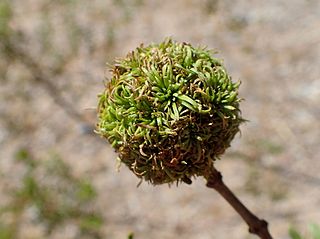
Creosote gall midges are a species of gall-inducing flies in the Asphondylia auripila group. This group consists of 15 closely related species of flies which inhabit creosote bush sensu lato. They have partitioned the plant ecologically with different gall midge species inhabiting the leaves, stems, buds, and flowers of creosote bush. Each species induces a uniquely shaped gall but the insects are otherwise morphologically very similar and very difficult to tell apart.

The Cecidomyiinae, commonly known as gall midges or gall gnats, is the largest subfamily in Cecidomyiidae with over 600 genera and more than 5000 described species. This subfamily is best known for its members that induce galls on plants, but there are also many species that are fungivores, parasitoids, or predators as maggots.
Asphondylia neomexicana is a species of gall midges in the family Cecidomyiidae.

Asphondylia is a cosmopolitan genus of gall midges in the family Cecidomyiidae. All species in this genus induce galls on plants, especially on flowers and flower buds. There are over 300 described species in Asphondylia, with many more likely to be discovered and described, especially in the southern hemisphere.

Asphondyliini is a tribe of gall midges in the family Cecidomyiidae. There are about six genera and at least 100 described species in Asphondyliini.
Asphondylia websteri, the alfalfa gall midge, is a species of gall midges in the family Cecidomyiidae.
Asphondylia betheli is a species of gall midge in the family Cecidomyiidae. This midge is widespread in the southwestern United States. The larvae of this species induce galls on in the fruit of Opuntia cacti.

Asphondylia rudbeckiaeconspicua is a species of gall midges in the family Cecidomyiidae. The larvae induce galls on Rudbeckia laciniata in North America. It was first described by Carl Robert Osten-Sacken in 1878.
Asphondylia lacinariae is a species of gall midges in the family Cecidomyiidae.

Asphondylia auripila is a species of gall midge in the family Cecidomyiidae. It forms galls on Larrea tridentata stems.
Asphondylia prosopidis, the mesquite gall midge, is a species of gall midges in the family Cecidomyiidae.

Asphondylia floccosa, the woolly stem gall midge, is a species of gall midges in the family Cecidomyiidae. The larvae induce galls on Atriplex polycarpa. They don't feed on the gall itself, but rather fungus that grows within the gall. Each gall can contain anywhere from one to fifteen chambers. This species is known from Arizona and California, and was first described by American entomologist Raymond Gagne in 1968.
Asphondylia ratibidae is a species of gall midges in the family Cecidomyiidae.

Asphondylia ceanothi, the ceanothus bud gall midge, is a species of gall midges in the family Cecidomyiidae.

Asphondylia solidaginis is a species of gall midge (Cecidomyiidae) that induces galls on goldenrods in North America where it is widespread. It was first described by William Beutenmuller in 1907.
Asphondylia monacha is a species of gall midges in the family Cecidomyiidae.
Asphondylia ambrosiae is a species of gall midge in the family Cecidomyiidae.
Asphondylia amaranthi is a species of gall midge in the family Cecidomyiidae.
Asphondylia antennariae is a species of gall midge in the family Cecidomyiidae. The larvae of this species induce galls on the buds of Antennaria plantaginifolia. This species is known from Wisconsin and Maine in the United States, though it's host plant is widespread in eastern North America. It was first described by American entomologist William Morton Wheeler in 1889.
Asphondylia artemisiae is a species of gall midge in the family Cecidomyiidae. The larvae of this species induce galls on at least one species of sagebrush Artemisia (plant). This species is only known from Arizona in the United States. It was first described by American entomologist Ephraim Porter Felt in 1908.









